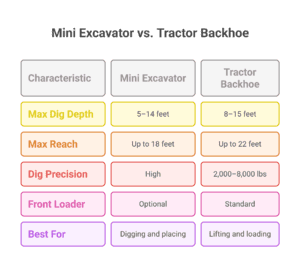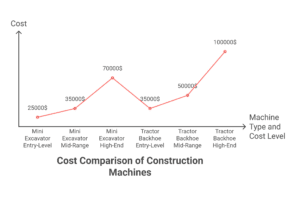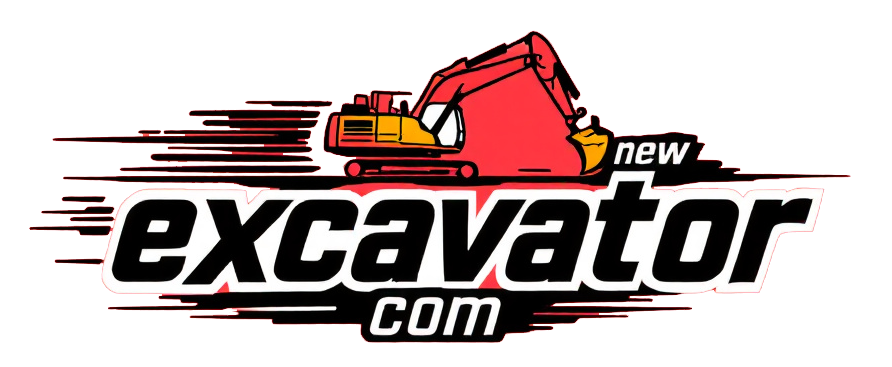Introduction
The Ongoing Debate in Compact Equipment
In the case that you are looking for a small digging machine, one of the first things you come across will probably be a mini excavator and a tractor backhoe – the two best sellers in the industry. Both have their proponents and a long list of advantages and disadvantages, which makes it very difficult to differentiate unpacking them which one is better.
Mini excavators are well-known for their small sizes, tight maneuverability, and responsive controls. Meanwhile, backhoes, with their digging and loading capabilities, have been the primary sources of solving the long-standing problems of agriculture and general contracting.
So which one do you think is the best?
Purpose of This Comparison
This is a comprehensive comparison of Mini excavators vs tractor backhoes in real-life cases, this guide is designed to help you figure out which one is better by going through:
- Specifications and performance
- Costs and maintenance
- Versatility and transport
- Use cases for contractors, farmers, and municipalities
Are you a contractor who is looking for an update, a farmer who needs a utility machine, or a first-time purchaser trying to intelligently invest? Then this guide will be an excellent help to you in deciding which machine can offer the most value for your money.
Who Needs to Make This Choice?
The decision of killing one to save the other is most helped by this comparison in the case of:
- Small contractors and landscapers
- DIY property owners
- Farmers and rural businesses
- Rental companies and fleet managers
- Municipal or county maintenance teams
While the machines have many similarities such as being compact, having a high horsepower rating, and being built for a specific purpose, both excel in very different environments. Wrong decision will end up costing you more in several ways such as fuel, downtime and missed project opportunities.
We are not just comparing, we are digging into the differences.
What Is a Mini Excavator?
Core Features and Capabilities
A mini excavator is a small tracked digging device with a typical weight of between 1 to 10 tons. Mainly used in small to medium-scale digging and trenching jobs. These machines come with:
- 360-degree rotating cab for visibility and reach of up to 360 degrees
- Deep and precise digging with the combination of boom and arm
- Off-road maneuvering with the use of rubber or steel tracks
- Multiple attachments can be run by having auxiliary hydraulics
Their ease of transportation, low ground pressure, and smooth controls add up to the list of mini excavators’ advantages, making them perfect for tight-access projects.
Common Applications and Job Types
Mini excavators are being used in a variety of industries. List of a few of them is given below:
- Landscaping and hardscaping
- Residential foundation work
- Utility line trenching
- Site prep and grading
- Fence and post hole digging
They are capable of working in backyards, narrow alleys, and urban areas where large machines cannot be used, and thus, they are considered the best.
In addition, the compatibility with buckets, augers, breakers, and grapples makes them real multi-taskers.
Advantages of Mini Excavators
The following are the main reasons why many experts refer to a mini excavator as their choice machine:
- Maximum visibility and accurate digging
- The ability to move around in limited areas
- Less damage to the turf and hardscapes
- Hydraulic couplers for rapidly changing attachments
- High resale value because of the demand for rental markets
And due to the technology changes like tilt rotators, precise controls, and emission reduction, they are becoming more and more efficient and eco-friendly.
What Is a Tractor Backhoe?
Overview of Its Design and Function
The backhoe loader, or simply the backhoe, is a machine equipped with two instruments that serve as its main tools:
- The front loader bucket for pushing, scooping, and hauling
- The rear-mounted excavator arm for digging
The machines are designed on a tractor-style frame that makes them wheel-based, thus faster on roads, and suitable for dual-purpose tasks.
Backhoes usually are in the range of 6,000 to 20,000 pounds and have a reputation for being sturdy, reliable, and ready for the field.
Typical Use Cases for Backhoes
Backhoes are the leading tools in scenarios where you require both digging and material handling, such as:
- Farm and ranch operations
- Small construction and demolition
- Roadside maintenance and ditch work
- Utility installation and pipework
Backhoes can be found at work clearing snow in the winter and trenching fence lines in the spring, a truly seasonal all-rounder.
Strengths of Tractor Backhoes
The following are the main features that make backhoes a strong competitor:
- A loader that comes as standard with backhoes gives you two sets of working capabilities
- Can be easily driven on roads for long distances
- Usually come with larger digging buckets
- More appropriate for rural or farm work
- Better at handling loose earth in general
Moreover, backhoes tend to be less intimidating and the operators who have the experience of driving a tractor find them more comfortable to handle.
Side-by-Side Specification Comparison
Size and Maneuverability

Winner: Mini Excavator Mini excavators are more compact, offer full rotation, and can spin in place—making them the king of tight quarters.
Digging Depth and Reach

Winner: Tractor Backhoe
With a built-in loader and more lift capacity, backhoes outrun mini excavators when it comes to loading and material transport as well as other work related to the backhoe.
Job Site Versatility and Adaptability
Urban vs Rural Usage Scenarios
Mini excavators are basically made for urban and residential job sites. They move in narrow alleyways, driveways, and yards that have been landscaped without any trouble. Their zero or reduced tail swing structures lessen the possibility of injuring the nearby buildings, and their lighter weight is just right for turf or pavers.
Meanwhile, tractor backhoes do well in the country and in the agricultural sector. Since their wheel-based design, they are able to go between fields, job sites, or properties without the need for a trailer. That is why they are perfect for road maintenance, drainage ditching, or loading manure and soil.
Winner: Mini excavators are the best for urban situations and backhoes are suitable for rural areas.
Attachments and Multi-Tool Use
Mini excavators are very versatile in terms of attachments. They can be equipped with:
- Augers
- Hydraulic breakers
- Tilt buckets
- Grapples
- Rippers
- Trenchers
- Brush cutters
By using the hydraulic quick couplers, the tool can be changed without the operators having to exit the cab, thus making the workflow faster and more efficient.
Backhoes do have the capability to add attachments but not as much as the mini-excavators. Most of them can only install buckets, forks, and snow plows unless there is a support for an aftermarket coupler system. At least the loader bucket makes the machine more versatile for pushing or loading materials.
Winner: Mini excavator.
Terrain Compatibility
The stability of tracked mini excavators is unparalleled on soft ground, slopes, or even muddy areas. They do not only weigh more evenly but also minimize the extent of ground disturbance thus, they are great for landscaping or working in sensitive environments.
Backhoes with their tires can be considered as good for firm ground and road travel. Nevertheless, they are not capable of operating on steep grades or muddy fields and hence, they might need stabilizer legs for digging.
Winner: Mini excavator for off-road or soft terrain.
Cost and Ownership Considerations
Initial Purchase Price Comparison

Mini excavators for the most part are cheaper to buy, especially the small ones (under 5 tons). The single design of the tractor backhoe, which also has bigger engines, causes them to be more expensive.
Fuel Efficiency and Maintenance Costs
Mini excavators generally use less fuel per hour compared to backhoes. The diesel engines of mini excavators are smaller and more efficient, especially when idling or using the hydraulic system. Several new models have been certified as Tier 4 compliant thus, reducing emissions and fuel consumption.
Maintenance on a mini-excavator is also less complicated:
- Less number of parts that are subject to movement
- There is no need to take care of the loader arm
- The hydraulic system operates under lower pressure
Backhoes will have to go through maintenance more often for their front and rear systems in addition to the tire.
The one that can make it through: Mini excavator.
Long-Term Value and Resale
While both machines are good at retaining their value, the mini excavators are more likely to have better resale value in hot rental markets or urban contractors. Their smaller footprints and lower costs make them alluring for resale.
Backhoes, however, are still largely used in rural markets and among municipalities and thus they may have a longer time to be sold privately.
Ease of Use and Operator Learning Curve
Control Systems and Interface
Minimal excavators are pretty much equipped with easy-to-understand joystick controls that also grant the operator a full 360-degree view from the seat. It happens that alongside the basic stick and boom movements, practically all other functions become effortless-especially with modern machines that allow setting speed and hydraulic flow through the adjustment.
The locations of the primitives of control for backhoe are:
- Loader controls (steering wheel, levers) located in the front
- Backhoe controls (two levers, swing arc) located in the rear
It takes longer to adjust quickly when you switch from one to the other and in this way, you are adding to the learning curve.
Winner: Mini excavator (more logical to become familiar with the concept in lesser time)
Cab Comfort and Visibility
Contemporary mini excavators have completely safe, air-conditioned, and sealed cabs with:
- Panoramic windows
- Suspension seats
- Joystick controls
- Bluetooth and display screens
Backhoes, on the other hand, give you a choice of a bigger cab o…
Winner: Tie (mini excavators are more compact, but backhoes offer comfort)
Training Requirements
Mini excavators can be operated even by novices without much time and effort. A few rental yards provide operator training in less than an hour.
More controls are found on a backhoe and in addition to more practice for the switching between loader and backhoe the whole functions take time to get used to.
Transport and Storage Factors
Towing and Hauling Requirements
Mini excavators have a light enough weight that they are able to be towed by a pickup and a trailer (this especially refers to models under 3 tons). Moreover, many models are compatible with dual-axle trailers not requiring a driver’s license for transportation.
On the other hand, backhoes are more massive and wider, thus often accompanied by:
- A trailer of a larger size
- A truck with heavy duty
- Maybe even authorizations for road travel
Footprint and Job Site Access
Mini excavators have a ability to get through 36-inch gates or operate in backyards, basements, and narrow streets. These machines’ small width and track system make them able to work in areas that backhoes are not.
Backhoes require a lot of space to be capable of turning, swinging, and stabilizing. Installation of those machines in small residential lots or in urban infrastructure is not possible.
Storage and Shelter Needs
Mini excavators could be kept in:
- A garage or barn
- A job site box
- A 20-foot container
In contrast, backhoes have to be parked in a larger area and there should be enough space above the boom and loader arm to accommodate the overhead clearance.
Ideal Use Cases for Mini Excavators
Landscaping and Tight Access Work
When you are in the landscaping business or are regularly working in residential areas, you will find that mini-excavators are a must-have. Because of their small footprint and zero-tail-swing configurations, you can:
- Dig trenches for irrigation or lighting
- Grade driveways or patios
- Install fences, retaining walls, and footers
- Remove stumps and roots
A lot of landscapers fit their machines with tilt buckets, grapples, and augers to make the most of their time.
Since mini excavators cause very little ground disturbance, they are ideal for turf-sensitive or decorative landscapes. Their track systems distribute the weight, thus reducing ruts and the need for extra cleanup.
Utility Trenching and Small Excavation
Mini excavators are a top pick for utility contractors for various reasons. They can:
- Cut trenches for water, gas, or electrical lines
- Fit in between structures or in alleyways
- Use narrow trenching buckets or vibratory plows
Their hydraulic systems are designed for supporting the usage of specialized attachments like compactors or cable plows, hence they can be considered the most suitable machine for precision installs.
If you are dealing with telecom, plumbing, irrigation, or lighting installs, a mini excavator will save you time, labor, and will prevent you from having a headache.
Residential and Commercial Renovation
In the midst of a tight city or while remodeling a house, backhoes are generally too large or too heavy. Mini-excavators are successful in:
- Basement digs
- Foundation repair
- Pool and hot tub installs
- Driveway grading
- Retaining wall excavation
Rotation on the spot, as well as the tilt/rotator bucket’s control, gives you precision so fine that you hardly even have to worry about the existing buildings.
Besides, you can work in backyards or through side gates without tearing up lawns or walkways.
Ideal Use Cases for Tractor Backhoes
Farm and Agricultural Projects
Backhoe maybe should be the first farm tool on a farmer’s list indeed. They are able to:
- Dig trenches for irrigation
- Load manure, gravel, or hay
- Pull fence posts
- Create culverts or ponds
- Push snow or debris
The front-end loader is especially useful for hauling materials around the property—something a mini-excavator can’t do without a separate skid steer or loader.
For the farmer who needs one machine to do it all, the backhoe is hard to beat.
Roadside and Municipal Work
Municipal crews rely on backhoes for:
- Ditch cleaning
- Snow removal
- Pothole patching
- Water line repairs
- Utility pole installs
They can drive directly to job sites, saving time on transport. Their dual-function nature allows city and county crews to respond to a wide range of maintenance calls without switching machines.
Backhoes also handle uneven shoulders and roadside terrain better than compact equipment, which might struggle to stay balanced or reach over guardrails.
Dual Purpose Use (Loader + Digger)
Nothing can be faster than a backhoe when you have to dig as well as load at the same time. For instance:
- Dig the trench by using the backhoe arm
- Load the spoil into a dump truck with the front bucket
- Level a road by using the loader blade
In places like farms and building sites, where efficiency is the king and time is short, the backhoe’s double utility is the winner of the day by far.
Which Machine Is Best for You?
Owner-Operators and Contractors
Suppose you are a single operator or a small contractor:
- Opt for a mini excavator, especially if you were engaged in digging, grading, or landscape works.
- On the contrary, pick up a backhoe if you are frequently required to move materials or work in an area where transport trailers are not permitted.
Mini excavators can be taken easily by car, lesser training is needed, and there is a great variety in the use of attachments.
Municipal Crews and Maintenance Teams
Towns, cities, and counties will also benefit from:
- Tractor backhoes for general roadwork and ditching
- Mini excavators for sidewalk, park, and infrastructure repairs
Most municipal fleets invest in both, but if the budget allows for only one machine, backhoes would be the more multipurpose infrastructure option.
Rural Landowners and Farmers
Farmers and large landowners get a backhoe as a tool that can load, lift, and travel. It is possible to make your gravel road, dig ditches, and plow snow without changing the seat.
On the other hand, if you have a lot of trees and steep slopes on your land, a mini excavator with a thumb or mower could be the way to go.
Bottom line: Don’t pick a machine just because of a few rare jobs. Instead, decide which one fits best with the jobs you do most often.
Conclusion
The choice between a mini excavator and a tractor backhoe essentially depends on what you want, the land, and the way you work. The precision, the ability to move in tight spaces, and the compatibility of attachments are the factors where mini excavators are superior to backhoes, while backhoes are more powerful in combined performance and are easier to use in rural areas.
Moreover, if you are into trenching, working in residential areas, and making your transport easier, then go for the mini excavator. On the contrary, if you are into loading, lifting, and traveling on the road then the backhoe is the perfect fit for you.
The best machine is the one that makes a difference in your efficiency, your earnings, and the lessen your anxiety on every job. Take this manual to correlate your device with your purpose – and proceed without any doubt.
